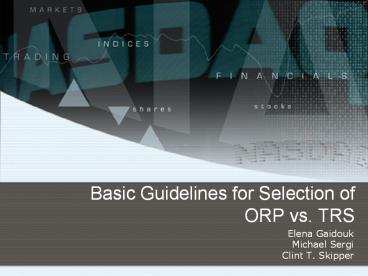Basic Guidelines for Selection of ORP vs. TRS - PowerPoint PPT Presentation
Title:
Basic Guidelines for Selection of ORP vs. TRS
Description:
... Guidelines for Selection of ORP vs. TRS. Elena Gaidouk. Michael Sergi. Clint T. Skipper. Why Our Problem Is Important? UH faculty have to choose between TRS and ... – PowerPoint PPT presentation
Number of Views:130
Avg rating:3.0/5.0
Title: Basic Guidelines for Selection of ORP vs. TRS
1
Basic Guidelines for Selection of ORP vs. TRS
- Elena Gaidouk
- Michael Sergi
- Clint T. Skipper
2
Why Our Problem Is Important?
- UH faculty have to choose between TRS and ORP.
- Enrollment in ORP in lieu of TRS is a
one-time, irrevocable decision. - Therefore some ORP-eligible employees may have
difficulties in making this choice, which would
ultimately affect their past-retirement income.
3
Procedures Used
- In this project we outlined major points that
should be considered while making this decision
and provided basic guidelines for the selection. - We also developed linear compensatory model using
three major cues age of the employee, attitude
towards risk, and job security (such as tenure).
4
Findings
- TRS
- Provides benefits for service retirement,
disability retirement, and death of a member or
retiree - Statutory retirement formula
- years of service x
- average of highest five annual salaries x 2.3
5
Findings (cont.)
- ORP
- An individualized retirement plan in which each
participant selects from a variety of investment
products provided by several companies that are
authorized by the employing institution.
6
Major Difference
- The essential difference is that TRS is a defined
benefit program, while ORP is a defined
contribution program.
7
What Does It Mean?
- Optional Retirement Program
- Benefits are determined by the contributions and
investment earnings in a person's account. - The employee bears the investment risk.
- The employer's responsibility is to make the
scheduled contributions. - Members have individual choices among
investments. - Benefits consist of the account balance, which
can be annuitized for lifetime income.
- Teacher Retirement System
- Benefits are determined by a formula, and benefit
levels are guaranteed. - The employer bears the risk.
- Investment performance affects funding, and does
not directly affect benefits. - Members have no individual control of benefit
levels. - Benefit levels are guaranteed for a retiree's
lifetime.
8
Other Differences
ORP TRS
Vesting One year plus one day Five years
Portability Full None
Disability Does not provide benefits Provides benefits
Survivor Does not provide benefits Provides benefits
9
Other Differences (cont.)
- Risk of Insolvency
- Currently, the TRS has an actuarial valuation of
assets at 89,299 M with an accrued actuarial
liability of 102,495 M. This is a 13,196 M
deficit or assets equal to 87.1 of liabilities - The percentage of assets to liabilities has been
eroding since 2000
10
TRS Financial Condition
- The state may need to increase its contribution
to the program to meet the shortfall.
11
ORP and Market Risk
- Enrollees in the ORP plan are exposed to market
risk. - Enrollees can be over exposed to risk at
different stages of their career. - Returns from proper investment mix can increase
retirement benefit. - How much risk must be taken to achieve the 8 TRS
return?
12
Other Differences (cont.)
- Cost of Living Adjustment
- Currently no recurring inflation adjustment to
pension plan - Ad-hoc adjustments to catch-up with inflation
- Legislation can pass benefit increase when fund
is sufficiently sound for 31 years - In other words, cannot when unfunded liabilities
of plan exceed 31 years - Every legislation since 1975 has made COLA
adjustments - 1993 Four installment plan to replenish fund
purchasing power - Round 1 in 1993- 5-15 increase, with older
retirees getting high end - Round 2 in 1995- 14 increase
- Round 3 in 1997- 7.5 increase
- Round 4 was supposed to occur in 2001, but
instead changed multiplier - Currently active pursuit to urge Texas
Legislature to annualize a minimum pension COLA
13
Other Differences (cont.)
- Cost of Living Adjustment contd
- To put into perspective- imagine employee who
entered the TRS plan in 1992 - 1993- 5 increase (assuming minimum adjustment)
- 1995- 14 increase
- 1997- 7.5 increase
- Total of 26.5 increase, or roughly 2 per year
- 26.5 increase/14 years 1.90 per year
- Assuming TRS auditors 3 inflation estimate,
this individuals pension should have been
adjusted by 42 - 14 years times 3 42
- Proposal for 80th Legislation session to waive
31 year rule and grant annualized pension
cost-of-living adjustments - Bottom line The Rule of 31 Law is eroding the
purchasing power of TRS retirement benefits
14
Who Should Choose ORP?
- Employees who terminate employment at a
young/middle age - Employees hired at young ages
- Employees with modest pay increases over a career
- Employees who achieve a higher rate of investment
return, through personal investment selection - Employees with short life expectancy
15
Who Should Choose TRS?
- Employees who retire early
- Employees hired in mid-career
- Employees with substantial pay increases at the
end of career - Employees who try to avoid any risk associated
with the investment decisions - Married employees, because of survivor benefits
- Employees with long life expectancy
16
More Complicated Cases
- Use Linear Compensatory Model
- O A R S
17
Limitations
- We are not experts
- In our linear compensatory model we use only
three cues, while there are other ones - The weights assigned to cues in the model may be
wrong - Our model mostly addresses strong preferences
cases - Our model has not been tested
18
Thank you!
- We wish you all































